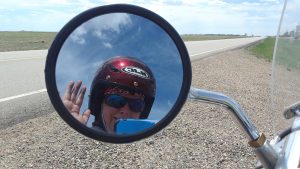Guest post by Emily Gillies, Master Holding Space Practitioner
From the glorious summer Saskatchewan, Canada prairies, here’s another installation of how motorcycling is akin to holding space, from me, Emily Gillies! I am a Master Practitioner with the Centre for Holding Space and am riding the joy of having witnessed two groups of incredibly skilled and warm-hearted Certification Candidates become Certified Practitioners over the last two years in the Centre’s Certification Program. (By the way, if you have completed the Foundation Program, registration is open for the next session starting in October 2022!) I have also been riding my motorcycle and thinking again how so many holding space concepts dovetail nicely with the lessons I learn on two wheels.
Two years ago, I wrote about these six topics:
- The autonomy rests with each person.
- Make group agreements before starting out.
- Celebrate rotating leadership.
- Focus and be present to do it well.
- Know your own capacity.
- Surround yourself with people you trust.
Here are seven more themes that come to mind while I practice both riding and holding space:
1. Discover your unique passion. Many participants of the Holding Space course have remarked, “I feel like I was doing this in life already, before I knew the language around it. I feel called to do this naturally.” This is the same for me and my son as motorcycle riders. Matthew loves his dirt bike: he loves varying his speed and dodging trees. He goes on twisty dirt paths, tight precipices beside sheer drop-offs, and performs jumps. This is not at all the way I ride my bike: just give me flat out speed on a flat straight highway. We each came to these preferences instinctively. We celebrate our individual styles as we develop them further.
With Holding Space practices, you might be drawn to something different than what you see modelled around you. Perhaps you resist leading group activities but you really shine in one-on-one roles. Maybe you incorporate somatic practices in a way that’s never been done before, or there are certain poetry pieces that uniquely call out to you as check-in prompts when hosting circles. Whatever gives you a nudge or makes your heart sing in this work, don’t be afraid to follow it.
2. Take responsibility for resourcing yourself. Just as a motorcyclist makes sure they start the day with a full gas tank, appropriate clothes if it gets colder or hotter, and their wallet for meal stops, when we hold space we are expected to show up with what we need for work ahead of us. If I’m going to support someone through a difficult conversation, I have first done my own inner work so I can be present for them. When I’m teaching a class or hosting a circle, I have prepared my notes and brought the necessary items such as a talking piece or a bell. If I’m especially fatigued or triggered, it’s up to me to figure out why and what to do about it. Recognizing my own autonomy I know that no one else can do the work for me, and it’s my job to anticipate my own needs. I don’t expect my riding partner to load my saddlebags for me, so neither do I presume others will handle emotional labour on my behalf. As my bike needs to be in good working order to be of any use, I keep up with regular maintenance of oil changes and new tires. That is the same self-care I extend to myself with good daily practices for health and well-being, and taking the time for extra rejuvenation like a personal retreat, a therapy session or a massage.
3. Let the process be intuitive. Sometimes I start out on a ride with a certain destination in mind, and sometimes I decide where I’m going as the journey unfolds. Sometimes the speed that felt good yesterday is too fast for my mood today. Depending on the weather, on my needs in the moment, or just because I feel called in a certain direction, I’ve learned to trust the inner guiding voice. The same is true for my hosting skills in circle or in a private conversation. Sometimes the objective is clear, but other times you have to sense your way forward by keeping an eye on the emotional skies and the maps handed to you by others. Sometimes what worked previously doesn’t have the same effect another time, and as the space holder it’s good to be adaptable.
4. See the value in both learning to do this alone and to do it with others. I learned to ride a motorcycle completely on my own, never having been on a bike before or having friends that rode. I spent the first two summers out on my own, relying only on myself for company and decision-making as I gained experience in this new skill. The next summer I started riding with someone and the change of being aware of another rider, taking their preferences of speed, duration and destination into account, and the joy of sharing the scenery together altered the dynamic so that it felt like a completely different experience… The two sides of the coin that is Holding Space is how we hold space for ourselves, and how the practice is similar and different when holding for others. There are benefits to developing and embracing both.
5. Find the practices that support you. My motorcycle holds space for me. While on it I do really good thinking and processing, I find freedom and ease, and it’s a natural way to centre and return to my whole self. In other times of life I’ve found this through photography, yoga and journalling. A large part of holding space work is knowing how to hold space for yourself and prioritizing it. You might find this through an art practice, music, a long bath, being out in nature, or any number of things. Be intentional about making time for these practices and notice how you feel before and after you complete them.
6. Consider how ‘brave space’ is better than ‘safe space’. If I had let safety dictate my interest in motorbikes, I never would have bought one! Motorcycling is one of the most dangerous activities one can engage in, and one of the most complicated things I’ve ever taught myself to do. From struggling with basic mechanical knowledge, to the dozens of miles where I practiced alone in a farmer’s yard prior to getting my license, to the times I’ve been cold and afraid watching dark clouds gather when I’m far from home, there has been much to learn and many reasons to give up. I pushed myself to overcome these obstacles not because I was seeking safety in life, but because I wanted to explore new things. That meant getting out of my comfort zone with courage and willingness to fumble.
We also talk about brave space when creating conditions for growth and honest conversation. When we hold space that prioritizes safety and upholding of the status quo, we miss out on opportunities for development. It’s a risk to try new things, and a good space holder can invite others to take that risk.
7. This isn’t one-and-done learning. Getting my license wasn’t the end of challenges. The first time I accelerated to highway speed it was terrifying, and I had to literally learn on the fly. Since then I’ve embarrassingly dumped my bike on its side in a parking lot, and I’ve had to adapt to different road conditions. Stepping into the role of solo female rider carries a social stigma that can be hurtfully judgmental, very vulnerable and overly objectifying. Last week I rode with a group of 12 other bikes, and while it was exhilarating, it was also intimidating. After nearly four years and many thousands of kilometres with my license, I still had a learning experience. I had to be aware of new things, stay respectful of the power of so many bikes together, lean into nuances of watching and thinking differently than I had before.
As I continue deepening in holding space work, I know there will be evolving opportunities for me to host circles in new spaces, imagine conversations that have never occurred before, and be in changing practices in this work. I hope to carry a learner’s mindset with me, a curious and humble posture, that serves me well in new situations.

